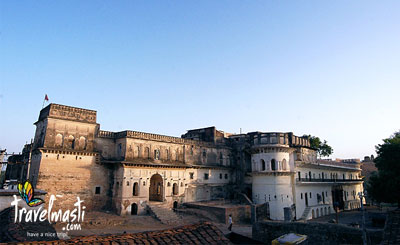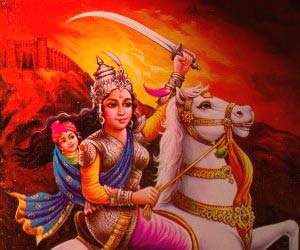In 1842, Manikarnika was married to the Maharaja of Jhansi Raja
Gangadhar Rao and was thereafter named Lakshmibai, a name which would go
down in history and earn great respect. In 1851, the couple had a baby
boy who they named Damodar Rao, but unfortunately the baby died when he
was only four months old. Following the death of their infant son, the
Raja and Lakshmibai adopted the son of Gangadhar Rao’s cousin, named
Anand Rao (who was renamed Damodar Rao). This adoption was witnessed by a
British political officer. Raja Gangadhar Rao also gave a letter to the
British officer requesting them to give Lakshmibai the government of
Jhansi for the rest of her life.
The Raja died in November 1853 and the British, under Governor General, Lord Dalhousie applied the Doctrine of Lapse, stating that they would not recognize the adopted child as the legal heir of the Raja and would hence annex Jhansi to British territory. In reaction of the unfairness on the part of the British regarding her territory, Lakshmibai consulted a British lawyer and appealed for the hearing of her case in London. This appeal was turned down. The British seized the state jewels of Jhansi and, in 1854, gave Lakshmibai a pension of Rs.60,000 and ordered her to leave her palace and the fort. She moved into a place called Rani Mahal, which has now been converted into a museum.
After being expelled from her palace, Lakshmibai was firm about protecting Jhansi from British annexation. Lakshmibai began securing her position and formed an army of both men and women who were given military training in fighting a battle.
In May 1857, Indian soldiers were livid when they found out that the cartridges supplied to them by the East India Company were being greased with pork and beef fat to keep them dry. Soldiers were required to bite off the paper cartridge containing the gunpowder to load into their rifles. Since pigs are taboo for Muslims and cows sacred to Hindus, the soldiers were extremely unhappy with the East India Company. This eventually led to India’s First War of Independence breaking out on May 10th 1857. This war is also known as the Great Rebellion, the Sepoy Mutiny and the Uprising of 1857, among other names.
When Lakshmibai heard of this uprising, she asked British political officer Alexander Skene if she could arrange for herself a group of armed men for her protection. Skene agreed to Lakshmibai’s demand. Compared to the unrest in the region, Jhansi was comparatively calm. Lakshmibai assured her subjects that all was well and asked them not to fear the British.
Right till January 1858, Jhansi was at peace. When the British finally arrived in Jhansi they discovered that the Jhansi Fort had been well guarded. Sir Hugh Rose, who was commanding the British army, asked for the city to be surrendered with the threat that it would be destroyed. Lakshmibai refused to surrender and went on to defend Jhansi from the British.
The British bombarded the fort on March 24th, but were met with heavy fire in return. Jhansi sent a request to Tatya Tope (a famous Maratha leader in the First War of Independence) for help. An army of 20,000 soldiers headed by Tatya Tope reached Jhansi, but were unable to match up to the British forces. Fighting continued and, when Lakshmibai realized that resistance in Jhansi by her army was not resulting in anything, she decided to leave Jhansi and join forces with Tatya Tope and Rao Sahib (nephew of Nana Sahib, a Maratha aristocrat who led the First War of Independence).
Lakshmibai, along with her son Damodar Rao, escaped from Jhansi one night and reached Kalpi where she joined forces with Tatya Tope. Here, they occupied the town and prepared to defend it. The British attacked Kalpi on May 22nd 1858 and Lakshmibai and Tatya Tope were defeated. The leaders of this resistance, Lakshmibai, Tatya Tope, Rao Sahib and the Nawab of Banda fled to Gwalior where they joined the Indian forces who were guarding the city. Lakshmibai and her team wanted to occupy the Gwalior Fort for its strategic location, but Lakshmibai was unsuccessful in trying to convince the rebel leaders in the area to protect Gwalior against the British.
On June 16th 1858, General Rose’s forces annexed Morar. On June 17th of the same year, near Phool Bagh in Gwalior, British troops under Captain Heneage fought Indian forces being commanded by Lakshmibai as they were trying to leave the area. Lakshmibai dressed as a man in a Sowar’s uniform, completely armed on horseback, with her infant son tied to her back, began attacking the British troops. The British attacked back and Lakshmibai was grievously wounded. Since she did not want her body to be captured by the British she told a hermit to cremate her. Upon her death on June 18th 1858, her body was cremated as per her wishes. Three days after the death of Lakshmibai, the British captured the Fort of Gwalior.
Lakshmibai’s tomb is in the Phool Bagh area of Gwalior. She continues to remain an inspiration to generations of Indians and is remembered for her fearlessness and determination. Even British officer Hugh Rose who had wanted to annex Jhansi described Lakshmibai as “clever and beautiful” and as the “most dangerous of all Indian leaders.”
Lakshmibai's name lives on right till this day and a medical college in Jhansi, the Maharani Laxmi Bai Medical College is named after her. Apart from that, a women’s unit of the Indian Army has been named the Rani of Jhansi Regiment. Lakshmibai has also inspired generations of poets, writers and film makers who have tried to capture the essence of who Lakshmibai really was. The most famous poem composed on the Rani remains the one written by Subhadra Kumari Chauhan, titled “Jhansi ki Rani”, which is an extremely moving account of Lakshmibai’s life and her demonstration of courage and how she fought valiantly till the very end.
Also On This Day:
1980 - Shakundaladevi demonstrates the multiplication of two 13-digit numbers.
1989 - India and Pakistan decide to end the five-year-old confrontation in Siachen Glacier area by withdrawing and redeploying their forces.
The Raja died in November 1853 and the British, under Governor General, Lord Dalhousie applied the Doctrine of Lapse, stating that they would not recognize the adopted child as the legal heir of the Raja and would hence annex Jhansi to British territory. In reaction of the unfairness on the part of the British regarding her territory, Lakshmibai consulted a British lawyer and appealed for the hearing of her case in London. This appeal was turned down. The British seized the state jewels of Jhansi and, in 1854, gave Lakshmibai a pension of Rs.60,000 and ordered her to leave her palace and the fort. She moved into a place called Rani Mahal, which has now been converted into a museum.
After being expelled from her palace, Lakshmibai was firm about protecting Jhansi from British annexation. Lakshmibai began securing her position and formed an army of both men and women who were given military training in fighting a battle.
In May 1857, Indian soldiers were livid when they found out that the cartridges supplied to them by the East India Company were being greased with pork and beef fat to keep them dry. Soldiers were required to bite off the paper cartridge containing the gunpowder to load into their rifles. Since pigs are taboo for Muslims and cows sacred to Hindus, the soldiers were extremely unhappy with the East India Company. This eventually led to India’s First War of Independence breaking out on May 10th 1857. This war is also known as the Great Rebellion, the Sepoy Mutiny and the Uprising of 1857, among other names.
When Lakshmibai heard of this uprising, she asked British political officer Alexander Skene if she could arrange for herself a group of armed men for her protection. Skene agreed to Lakshmibai’s demand. Compared to the unrest in the region, Jhansi was comparatively calm. Lakshmibai assured her subjects that all was well and asked them not to fear the British.
Right till January 1858, Jhansi was at peace. When the British finally arrived in Jhansi they discovered that the Jhansi Fort had been well guarded. Sir Hugh Rose, who was commanding the British army, asked for the city to be surrendered with the threat that it would be destroyed. Lakshmibai refused to surrender and went on to defend Jhansi from the British.
The British bombarded the fort on March 24th, but were met with heavy fire in return. Jhansi sent a request to Tatya Tope (a famous Maratha leader in the First War of Independence) for help. An army of 20,000 soldiers headed by Tatya Tope reached Jhansi, but were unable to match up to the British forces. Fighting continued and, when Lakshmibai realized that resistance in Jhansi by her army was not resulting in anything, she decided to leave Jhansi and join forces with Tatya Tope and Rao Sahib (nephew of Nana Sahib, a Maratha aristocrat who led the First War of Independence).
Lakshmibai, along with her son Damodar Rao, escaped from Jhansi one night and reached Kalpi where she joined forces with Tatya Tope. Here, they occupied the town and prepared to defend it. The British attacked Kalpi on May 22nd 1858 and Lakshmibai and Tatya Tope were defeated. The leaders of this resistance, Lakshmibai, Tatya Tope, Rao Sahib and the Nawab of Banda fled to Gwalior where they joined the Indian forces who were guarding the city. Lakshmibai and her team wanted to occupy the Gwalior Fort for its strategic location, but Lakshmibai was unsuccessful in trying to convince the rebel leaders in the area to protect Gwalior against the British.
On June 16th 1858, General Rose’s forces annexed Morar. On June 17th of the same year, near Phool Bagh in Gwalior, British troops under Captain Heneage fought Indian forces being commanded by Lakshmibai as they were trying to leave the area. Lakshmibai dressed as a man in a Sowar’s uniform, completely armed on horseback, with her infant son tied to her back, began attacking the British troops. The British attacked back and Lakshmibai was grievously wounded. Since she did not want her body to be captured by the British she told a hermit to cremate her. Upon her death on June 18th 1858, her body was cremated as per her wishes. Three days after the death of Lakshmibai, the British captured the Fort of Gwalior.
Lakshmibai’s tomb is in the Phool Bagh area of Gwalior. She continues to remain an inspiration to generations of Indians and is remembered for her fearlessness and determination. Even British officer Hugh Rose who had wanted to annex Jhansi described Lakshmibai as “clever and beautiful” and as the “most dangerous of all Indian leaders.”
Lakshmibai's name lives on right till this day and a medical college in Jhansi, the Maharani Laxmi Bai Medical College is named after her. Apart from that, a women’s unit of the Indian Army has been named the Rani of Jhansi Regiment. Lakshmibai has also inspired generations of poets, writers and film makers who have tried to capture the essence of who Lakshmibai really was. The most famous poem composed on the Rani remains the one written by Subhadra Kumari Chauhan, titled “Jhansi ki Rani”, which is an extremely moving account of Lakshmibai’s life and her demonstration of courage and how she fought valiantly till the very end.
Also On This Day:
1980 - Shakundaladevi demonstrates the multiplication of two 13-digit numbers.
1989 - India and Pakistan decide to end the five-year-old confrontation in Siachen Glacier area by withdrawing and redeploying their forces.

